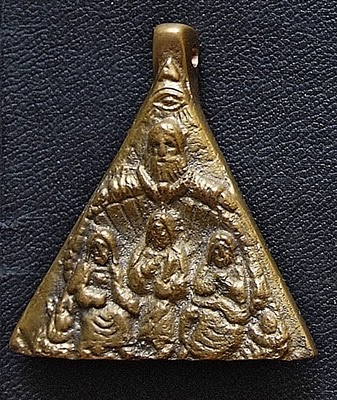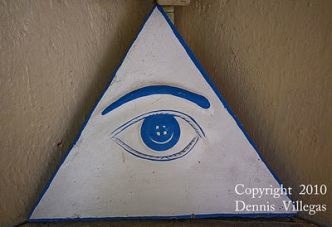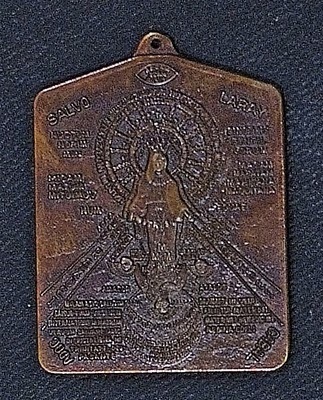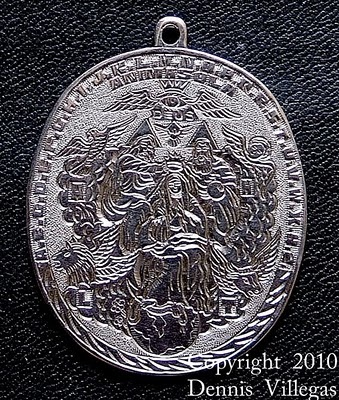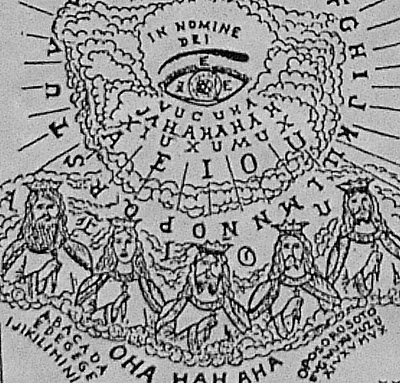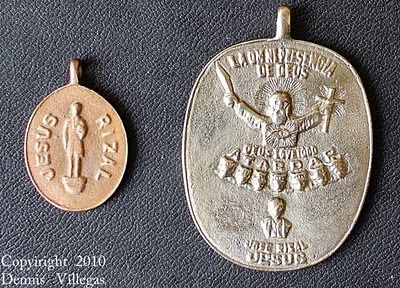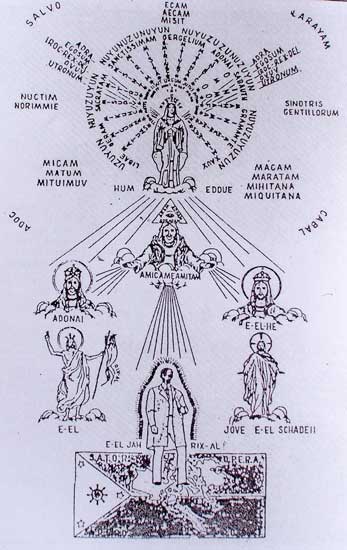And you shall be as gods:
The culture of the anting-anting (Part 1)
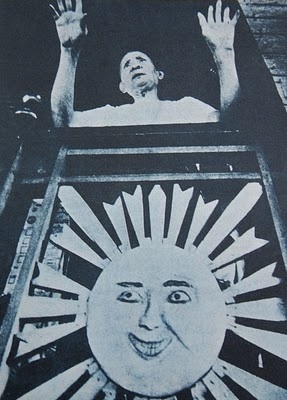
Deep in the night of May 20, 1967, around 400 curiously-attired
men congregated on Taft Avenue in Manila, near what is now Vito Cruz,
with the intent to march to Malacanang Palace to ask for President
Marcos’ resignation. The men wore
anting-anting and colorful
vests with mixed Latin and Tagalog inscriptions on them. Seemingly at
odds with their appearance, they were also wielding daggers and
three-foot-long jungle bolos signifying their rebellious intent. They
were part of the millenarian sect called
Lapiang Malaya (Freedom Society), a quasi-religious political society led by the charismatic 86-year-old Supremo
Valentin delos Santos,
a former Catholic priest, trained auto mechanic, one-time circus
performer, and failed candidate in the past three presidential elections
at that time.Early in May 1967, Tatang Valentin, as the Supremo was
called, had demanded that
Ferdinand Marcos
step down. He also wanted the Philippine Armed Forces to surrender
their arms to him. Deeply disillusioned by what he termed as the
oppression of the poor and the continuing evil influence of foreigners
in the Philippines, Tatang Valentin decided it was time to establish a
new government, with him as the new Supreme Commander,
Commander-in-Chief, and President of the Republic of the Philippines.
President Marcos promptly rejected Tatang Valentin’s demand.
As the
kapatid (“brothers,” as Lapiang Malaya members were
called) started to arrive from the provinces to gather in the society’s
compound in Pasay, the Philippine Constabulary cordoned off the area to
prevent more members from joining the already frenzied group.
Then at around 12:30 in the morning of May 21, as the tension between
the Lapiang Malaya members and the constabulary heightened, mock
gunfire rang in the air, allegedly shot by a prankster. A violent
skirmish between the
kapatid and the constabulary followed –
one that was so one-sided it was later to be called a massacre. As the
constabulary opened fire, 32 of the kapatid were killed and some 40
seriously wounded. The constabulary had one mortality: a soldier who was
hacked to death. In addition, five constabulary soldiers were wounded
by bolo hacks, and three civilians hit by stray bullets.
 One of the kapatid killed in the Lapiang Malaya massacre
of May 21, 1967. Note the sacred vest and scarf he wears that gave no
protection against bullets. Purist anting-anting believers would later
say that those killed lacked faith in their anting- anting.
One of the kapatid killed in the Lapiang Malaya massacre
of May 21, 1967. Note the sacred vest and scarf he wears that gave no
protection against bullets. Purist anting-anting believers would later
say that those killed lacked faith in their anting- anting.
This massacre of the Lapiang Malaya was one of the bloodiest episodes
in recent Philippine history. As the front-line members of the Lapiang
Malaya fell to gunfire, many other members realized their
anting-anting would not protect them. Dispersing in many directions,
they were later arrested and charged with rebellion.
Later that morning, Tatang Valentin surrendered to the constabulary.
He was brought to the National Mental Hospital, together with 11 of his
high-ranking lieutenants. All of them were subjected to psychiatric
evaluation and pronounced lunatic. Following his diagnosis, Tatang
Valentin was confined to a cell together with a violent patient, who
allegedly mauled the old man into a coma. He never regained
consciousness and was declared dead in August 1967. The official medical
report stated he died of pneumonia.
After Tatang Valentin’s death, the Lapiang Malaya was officially
dissolved by the government, with most members either pardoned or sent
back to their respective provinces. Most of these were peasants,
laborers, and common folks from Southern Tagalog who believed in Tatang
Valentin’s promise of a new government based on “true equality and true
liberty.” They also subscribed to Tatang Valentin’s promise of
supernatural powers once they wore their
anting-anting and
sacred vests. He convinced them that the bullets of the enemies would
turn into snakes and fall around them. But as it happened, and as proven
in the bloody morning of May 21, the amulets they wore were no match
for the automatic gunfire of the constabulary. The bullets easily tore
through their vests, flesh, and bones.
 Tatang Valentin delos Santos surrenders to the Constabulary
Tatang Valentin delos Santos surrenders to the Constabulary
In retrospect, the Lapiang Malaya massacre is just one of the many
episodes in the history of the Filipino mass movements whose combined
quest for freedom and faith in the
anting-anting led them to fight the oppression of those in power. The revolt of the
Cofradia de San Jose in 1840, the
Katipunan in 1896, the Colorum rebellions of Southern Tagalog in 1897, the
Philippine Revolution of 1899, the
Makario Sakay and
Felipe Salvador rebellions during the early years of the American occupation, and the Sakdal and the
Hukbalahap
movements – these are all examples of uprisings driven not only by
nationalistic fervor but by religious and superstitious beliefs as well.
The leaders and members of these movements invariably kept an
anting-anting to protect them in their battles against the enemies.
General Emilio Aguinaldo was known to possess the medallion of the Santissima Trinidad,
Andres Bonifacio
used the Santiago de Galicia amulet, Felipe Salvador wore the medallion
of Christ’s resurrection, and General Macario Sakay went around in an
anting-anting vest with the inscribed Caravaca cross design. General
Antonio Luna, Bishop
Gregorio Aglipay, and General
Miguel Malvar were also known to possess an
anting-anting.
The
anting-anting likewise figured prominently in the lives of folk heroes and bandits, such as Tiagong Akyat,
Nardong Putik, and Kapitan Eddie Set, whose life stories were made into movies by actor Ramon Revilla. But for all the presumed power of the
anting-anting they wore, most of these folk heroes and villains ended up being killed by gunfire in encounters with the authorities.
Even former President
Ferdinand Marcos, the man Tatang Valentin wanted to overthrow, was known to believe in the
anting-anting. Bishop
Gregorio Aglipay, reportedly a firm believer in
anting-anting, was said to have embedded an
anting-anting into the former president’s skin. Could it be that Marcos’
anting-anting was more powerful than Tatang Valentin’s?
Did Tatang Valentin and his men truly believe that the
anting-anting had the power to turn bullets into snakes? If so, why did the
anting-anting
fail to stop the bullets from penetrating through cloth and flesh? Was
Tatang Valentin truly a messiah from God as he claimed he was? Or was
he simply, as the government asserted, a madman? What is it in the
anting-anting
that attracts many Filipinos into believing in it? Where did it come
from? What is its history? More importantly, why would some Filipinos
suspend logic and place their lives in peril just because they possess
an
anting-anting?
The culture of the anting-anting

One of the vests of Tatang Valentin delos Santos (Author’s collection)
Every culture has produced its own set of talismans and amulets, and
the Philippines is no exception. While some cultures may regard amulets
merely as magical accessories to protect one against harm and bad
luck, the culture of the Filipino
anting-anting may be different, being so ingrained as to be regarded as a religion in itself. Notably, the
anting-anting
invariably contained mixed symbols of the ancient Filipino religion,
Roman Catholicism, the Christian Orthodox church, and Judaism.
For those who believe in its divine properties, the
anting-anting
is one of the few man-made objects that can make man closer to God or
even achieve the qualities of God. It is a long-held belief among the
mystics, both in the East and the West, that amulets serve as temporary
or even constant habitation of God and other divine spirits. The
animist belief that inanimate objects can become receptacles of
dwelling of the divine is shown through the ancient worship of statues,
relics, beads, portraits, tombs, and of course, amulets.
Before the coming of the Spaniards, the early Filipinos were already
known to keep amulets, talismans, charms, and various other objects to
protect them from harm, the elements, and the evil spirits. Crocodile
tooth, gems, odd-shaped stones, and even fossilized remains of animals
were the earliest known examples of
anting-anting used by the early Filipinos.
The anting anting has many other names in the Tagalog lexicon:
bertud, agimat, gamit, talisman,
mutya, or
galing.
It also comes in many forms. It can be a medallion, a small book, a
piece of paper, a tattoo, a crocodile tooth, a meteorite, a vest or
scarf inscribed with
oraciones, and many others. No one is quite sure how the word
anting-anting
came to be. According to Lorna Montilla, anting-anting may have evolved
from the Latin word “anti,” and thus means “anti-anti” or
“against-against.” Indeed if the present belief in the popular use of
anting-anting is to be considered, Montilla may be correct, since the
anting-anting
is mostly used to protect its wearer against harm and illness. But
there are also some who put forward the theory that the term is actually
derived from the Javanese word “
anting-anting” which means ear pendants.
Anting-anting may also have been derived from the Bahasa Melayu word “
anting” that means “dangling” or “swinging.”
 Anting-anting medallions in Quiapo
The enigma and promise of the anting-anting
Anting-anting medallions in Quiapo
The enigma and promise of the anting-anting
Part of the attraction of the
anting-anting lies in its esoteric nature. Basically, man is attracted to the unknown, to the mysterious. Most
anting-anting pieces are puzzling because of their cabalistic figures, mysterious
oraciones,
and hidden initials. Many people who possess these are very secretive
and would not want to reveal what they keep, except maybe those pieces
they wear around. They believe that the mystical nature of the
anting-anting–their
own covenant with the gods–is what makes it powerful. Once revealed to
others, its power diminishes or disappears altogether.
The secret symbols and initials are part of the original mystical theogony of the Tagalog. The
oraciones—the
prayers summoning the divine—are mostly hidden in initials. I found
that many of these initials are the numerous names of God and the words
God had spoken. For instance, the initials M.M.M. and A.A.A. appear on
many medallions which, according to anting-anting believers, are the
initials of the true names of the Santissima Trinidad (Holy Trinity). We
will unlock these secrets later in this article as we examine each of
the medallions.
Many of the symbols are connected with the Filipinos’ concept of God. The most commonly seen symbol is the Eye contained in a triangle,
which represents the Bathala or the Infinito Dios, the ancient Filipino
God. This symbol appears in many emblems, banners, and seals of many
millenarian groups in Southern Tagalog.
The connection of God to the
anting-anting, therefore, is key to understanding its nature. To unlock the secrets of the
anting-anting’s hidden meanings, myths, and symbolisms, one must be able to understand the Filipino’s concept of God. The
anting-anting
is the Filipino’s way to approach God, and to contain God within a
medallion or vest, and thereby achieve a divine connection which will
give him the qualities of God.
Another attraction of the
anting-anting is the promise it gives to its possessor. Many who keep them believe that the
anting-anting gives them spiritual power that can protect them from material harm. Many of the people who put their faith in the
anting-anting, such as the
kapatid of the Lapiang Malaya, held the notion that they gain supernatural powers through the
anting-anting.
They can become invisible to enemies, impervious to bullets and
knives, escape mortal dangers, be in two places at the same time,
perform miracles, and so on. Therefore, the
anting-anting endows them with the attributes of the gods.
With all these attributes of power and promise, many people who believe in the
anting-anting spend most of their lives searching for the most powerful ones. They go to the most remote places in search of the
anting-anting.
They undergo great sacrifice and peril to hunt them. For example, in
the past, it was a common belief that an unchristened fetus, recently
aborted or miscarried, must be exhumed from the cemetery, put into a
bottle or jar, soaked in liquor, and eaten one tablespoon everyday for a
whole year. The pickled fetus is still believed powerful by some of
the most radical faithful in the Tagalog region. This author knows of a
person who fell gravely ill after eating pickled fetus for a week.
There are also people who swallow the
anting-anting, in the belief that once ingested, its powers are absorbed by the body. This is called the
subo (swallow), still being practiced by many believers. Another extreme is the
baon, in which the
anting-anting is embedded into the believer’s skin, like what Marcos was said to have had inside the skin of his back.
The theogony of the anting-anting
The ancient Filipinos believed in the existence of God. In Tagalog
mythology, God is the Bathalang Maykapal or Bathala, the creator of the
universe. Although the name Bathala may be Tagalog, it has counterparts
in other parts of the Philippines. Bathala rules the world. He
provides man with his needs and protects the world against evil. There
are other deities in the ancient religion of the Tagalogs, but Bathala
is the highest and most powerful.
To make the conquest easy and readily convert Filipinos into the new
religion, the friar missionaries interpreted Bathala to be the same
Spanish God of the Roman Catholic religion. Rather than erase the old
belief in the Bathala, the friars simply adapted the Bathala into the
new faith. The friars may have even encouraged local beliefs and
superstitions among the Filipinos, including the belief in
anting-anting, to create a market for similar objects like scapulars, scarves, relics, medallions, and rosaries.
The veneration of material objects, long a tradition among the
Filipinos, has thus been encouraged and fused with Roman Catholicism.
The Filipinos then created their own interpretations of these objects to
suit their beliefs. Thus, many of the symbols that can be seen on the
anting-anting are fusions of the Roman Catholic faith and the pre-colonial religion of the Filipinos.
The important change instituted by the friar missionaries had
something to do with the concept of God among the Filipinos. Although
Bathala is interpreted by the friars to be the same Spanish God of the
Roman Catholics, Bathala’s monotheistic being was changed, as he was now
viewed as consisting of three persons. This is the Doctrine of the
Santissima Trinidad (Holy Trinity of God the Father, God the Son, and
God the Holy Spirit).
This doctrine is the most important dogma of Catholicism. In the book
Catechism of the Roman Catholic Church published by the Vatican, the
doctrine is stated:
The Trinity is One. We do not confess three Gods, but One God in
three persons. The divine persons do not share the one divinity among
themselves but each of them is God whole and entire.
 The Tres Personas or Santissima Trinidad. This image is
now banned in Roman Catholic churches, but is still being used in many
altars of Folk Catholic religions in Southern Tagalog, such as the
Tres Personas Solo Dios and the Iglesia Watawat ng Lahi. It is also
frequently used on anting-anting medallions and vests.
The Tres Personas or Santissima Trinidad. This image is
now banned in Roman Catholic churches, but is still being used in many
altars of Folk Catholic religions in Southern Tagalog, such as the
Tres Personas Solo Dios and the Iglesia Watawat ng Lahi. It is also
frequently used on anting-anting medallions and vests.
The early Filipinos may have difficulty understanding this concept of
the Santissima Trinidad. How can the Bathala be One and Three at the
same time? To solve this theological crisis, and to retain the easier
concept that the God is only One, the Tagalogs created the mythology of
the Infinito Dios. In this new theogony, Bathala is again One, but his
name has become the Infinito Dios, and immediately below him—but also
Gods in their own right —are the Santissima Trinidad: God the Father,
God the Son, and God the Holy Spirit.
The concept of the Bathala/Infinito Dios existing before the
Santissima Trinidad may seem easier to understand for the early
Filipinos. Here, the line is clear: the Infinito Dios is the One and
Only God. He retains his role as the creator of the universe, the
provider of mankind, and the protector against evil.
The later arrival of the Santissima Trinidad into the Filipino
theogony created the myth that the Santissima Trinidad, a newcomer in
Filipino theogony, wanted to baptize, i.e., convert, the Infinito Dios,
not knowing that the Infinito Dios was already existing even before the
Santissima Trinidad existed. The Infinito Dios is higher than,
although one with, the Santissima Trinidad.
 The altar of the religious sect Tres Personas Solo Dios.
In the pantheon of Gods, the Infinito Dios (Bathala) sits on a higher
level than the Santissima Trinidad. The Infinito Dios and the
Santissima Trinidad are One, however, consistent with the Roman
Catholic teaching that God is One in three persons.
The altar of the religious sect Tres Personas Solo Dios.
In the pantheon of Gods, the Infinito Dios (Bathala) sits on a higher
level than the Santissima Trinidad. The Infinito Dios and the
Santissima Trinidad are One, however, consistent with the Roman
Catholic teaching that God is One in three persons.
The Mythology of the Infinito Dios

The medallion of the Infinito Dios. The central figure
is that of Bathala/Infinito Dios being baptized by Jesus Christ, one of
the Santissima Trinidad. (Author’s collection)
The world of the Philippine
anting-anting is mainly based on
the mythology of the Infinito Dios. The Infinito Dios is represented
by a single eye in a triangle. This symbol is still widely used in many
folk Catholic religions in the Tagalog region, such as the
Iglesia Watawat ng Lahi, Ciudad Mistica de Dios, Tres Personas Solo Dios, to name a few. Even the
Katipunan
of Andres Bonifacio and later the revolutionary government of General
Aguinaldo—both of whom were known to have kept an anting-anting–used
this symbol in many of their official seals and banners.
 The Eye, symbol of God found in many anting-anting medallions
and scarves. This one was seen by the author on the foothills of Mount
Banahaw and Dolores, Quezon.
In the beginning, there was a bright light that covered the
entire universe. This light was called the Infinito Dios. There is no
God other than the Infinito Dios. He was the Animasola (Lonely Soul), a
winged eye wrapped in a shawl, forever changing his form while floating
in space. Soon the Infinito Dios decided to create the world. He
pulled the light in order to give way to the darkness. His light
receded until it became a small ball of light. The ball of light
suddenly had a gash on the lower portion that became a mouth. On top of
the mouth a line appeared that became the nose. On top of the nose
emerged two holes that became eyes. From these eyes came forth bursts
of flame. Parallel to the eyes, on the sides, two holes appeared that
became the ears. In short, the Infinito Dios, the ball of light, became
a figure resembling a man’s head.
The Eye, symbol of God found in many anting-anting medallions
and scarves. This one was seen by the author on the foothills of Mount
Banahaw and Dolores, Quezon.
In the beginning, there was a bright light that covered the
entire universe. This light was called the Infinito Dios. There is no
God other than the Infinito Dios. He was the Animasola (Lonely Soul), a
winged eye wrapped in a shawl, forever changing his form while floating
in space. Soon the Infinito Dios decided to create the world. He
pulled the light in order to give way to the darkness. His light
receded until it became a small ball of light. The ball of light
suddenly had a gash on the lower portion that became a mouth. On top of
the mouth a line appeared that became the nose. On top of the nose
emerged two holes that became eyes. From these eyes came forth bursts
of flame. Parallel to the eyes, on the sides, two holes appeared that
became the ears. In short, the Infinito Dios, the ball of light, became
a figure resembling a man’s head.

Animasola, the Winged Eye.This symbol is used in the
altar of the Ciudad Mistica de Dios, a religious millenarian group
located on Banahaw.
The Infinito Dios decided to create beings to assist him in his
task of creation. While thinking, the Infinito Dios suddenly had
perspiration on his right side. When he wiped his right side, the
droplets became 16 spirits. Two of these spirits became Uph Madac and
Abo Natac, the two elders who reside in the two corners of the Earth and
are the guardians of the Sun and the Moon. The next six spirits became
the beings who reside outside the earth. They did not want to receive
any blessings from the Infinito Dios. Their names are Elim, Borim,
Morim, Bicairim, Persulatim and Mitim. The next seven spirits became the
unbaptized Archangels named Amaley, Alpacor, Amacor, Apalco, Alco,
Arago, and Azaragoe.
 The first 16 spirit beings that emanated from Infinito Dios
The first 16 spirit beings that emanated from Infinito Dios
 The six spirit beings that did not want to take any authority from the Infinito Dios
The six spirit beings that did not want to take any authority from the Infinito Dios
 The seven archangels, unbaptized
The seven archangels, unbaptized
The last spirit was called Luzbel, a spirit whose name means
light of heaven. His name is Becca, the being who will later rebel
against the Infinito Dios. His other name is Lucifer.
Meanwhile, the Infinito Dios decided to create other beings.
While thinking, he suddenly perspired on his left side. Wiping the
perspiration, the droplets became eight spirit beings. Five of them
became the beings who went to Jesus Christ while he was nailed to the
cross to ask for his blessing. But before he could give his blessing to
these five spirits, Jesus expired. The five spirits never received
their blessings and therefore retained their original names of Istac,
Inatac, Isnatac, Tartaraw, and Sarapao.
The last three spirit beings became known as the Tres Personas,
or the Santisima Trinidad. The Infinito Dios gave them the task to
create the world and its inhabitants. On each of the eyes of the Tres
Personas can be seen the letter M, which is the initial of their names:
Magob, Mariagob, and Magogab.(1)
In the above mythology, one can gather that the Infinito Dios was the
beginning of everything. No one created the Infinito Dios. He was
there from the start, a floating Eye within a triangle wrapped in a
shawl. From him emanated the other spirit elders, the archangels,
Lucifer (Luzbel), and the Santissima Trinidad.
The Infinito Dios is the highest God in the theogony of the
anting-anting. Sometimes He is called the
Nuno,
or the oldest being from whom everything emanated. For this reason, the
Infinito Dios is a separate entity from the Santissima Trinidad
(Father, Son, Holy Spirit), although the latter emanated from his body
as perspiration, along with the other first beings of the universe. The
Infinito Dios gave the authority to create the world to the Santissima
Trinidad.









